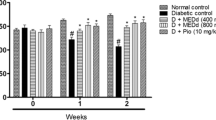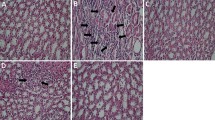Abstract
Purpose
Management of hepatorenal complications in diabetic patients is still a challenge for clinicians. The study aimed to investigate the impacts of ethanolic extract of Commiphora myrrha (Nees) Engl.oleo-gum-resin (EEM) against hepatorenal injury in diabetic rats.
Methods
Diabetes was induced by an intraperitoneal (i.p.) injection of streptozotocin (55 mg/kg) in adult male Wistar rats (n = 40); whereas, normal control rats (NC, n = 8) were treated with vehicle solution (citrate buffer, i.p.). Diabetic animals were gavaged with 500 mg/kg of metformin (MET500) and different doses of EEM (100, 300, and 500 mg/kg) once daily for 28 days. Diabetic model (DM) and NC groups were treated with normal saline. Various parameters like fasting blood glucose (FBG), plasma insulin, aspartate transaminase (AST), alanine transaminase (ALT), creatinine (Cr), urea, 24-h urine total protein (UTP), urine volume, and hepatorenal histopathology were assessed at the end of the study.
Results
Compared to the NC group, diabetic rats showed marked elevations in FBG, AST, ALT, urea, Cr, UTP, urine volume, and a significant reduction in insulin. Diabetic animals also exhibited severe histopathological alterations in liver and kidney tissues. The EEM treatment could not influence the biochemical and pathological alterations. Treatment with EEM at the dose of 300 mg/kg could slightly ameliorate some pathological alterations (fatty changes and tubular congestion) in hepatic and renal tissues.
Conclusions
These findings demonstrated that EEM treatment at doses up to 500 mg/kg could not effectively slow down the pathological process of hepatorenal damage in diabetic rats.


Similar content being viewed by others
Data availability
The datasets used and/or analyzed during the current study are available from the corresponding author on reasonable request.
Abbreviations
- Myrrh:
-
Commiphora myrrha oleo-gum
- EEM:
-
Ethanolic extract of myrrh
- AST:
-
Aspartate transaminase
- ALT:
-
Alanine transaminase
- UTP:
-
Urine total protein
- STZ:
-
Streptozotocin
- i.p.:
-
Intraperitoneal.
- FBG:
-
fasting blood flucose
- NC:
-
normal control
- DMSO:
-
Dimethylsulfoxide
- MET:
-
Metformin
- DM:
-
Diabetic model
- Cr:
-
Creatinine
- PAS:
-
Periodic acid-Schiff
- B.wt:
-
Body weight
- TGF-β1:
-
Transforming growth factor-Beta1
- EGF:
-
Epidermal growth factor
- VEGF:
-
Vascular endothelial growth factor
References
Herman WH, Petersen M, Kalyani RR, Response to Comment on American Diabetes Association. Standards of medical care in diabetes—2017. Diabetes Care. 2017;40:e94–5. https://doi.org/10.2337/dci17-0007.
Pizzorno J. Is the diabetes epidemic primarily due to toxins? Integr Med (Encinitas). 2016;15:8–17.
Bingham M. Elevated glucose levels tied to risks for microvascular complications in prediabetes. Diabetes Care. 2020;43:693–4. https://doi.org/10.2337/dc20-ti04.
Mohamed J, Nafizah AN, Zariyantey A, Budin S. Mechanisms of diabetes-induced liver damage: the role of oxidative stress and inflammation. Sultan Qaboos Univ Med J. 2016;16:e132-41. https://doi.org/10.18295/squmj.2016.16.02.002.
Chen Y, Lee K, Ni Z, He JC. Diabetic kidney disease: challenges, advances, and opportunities. Kidney Dis (Basel). 2020;6:215–25. https://doi.org/10.1159/000506634.
Alhadramy MS. Diabetes and oral therapies: a review of oral therapies for diabetes mellitus. J Taibah Univ Med Sci. 2016;11:317–29. https://doi.org/10.1016/j.jtumed.2016.02.001.
Kokil GR, Veedu RN, Ramm GA, Prins JB, Parekh HS. Type 2 diabetes mellitus: limitations of conventional therapies and intervention with nucleic acid-based therapeutics. Chem Rev. 2015;115:4719–43. https://doi.org/10.1021/cr5002832.
Laelago T. Herbal medicine use during pregnancy: Benefits and untoward effects. In: Builders, Ph, editors. Herbal Medicine. London: IntechOpen; 2018. https://doi.org/10.5772/intechopen.76896.
Andrade C, Gomes NG, Duangsrisai S, Andrade PB, Pereira DM, Valentão P. Medicinal plants utilized in Thai Traditional Medicine for diabetes treatment: Ethnobotanical surveys, scientific evidence and phytochemicals. J Ethnopharmacol. 2020;263:113177. https://doi.org/10.1016/j.jep.2020.113177.
Hassanzadeh-Taheri M, Hosseini M, Hassanpour-Fard M, Ghiravani Z, Vazifeshenas-Darmiyan K, Yousefi S, et al. Effect of turnip leaf and root extracts on renal function in diabetic rats. Orient Pharm Exp Med. 2016;4:279–86. https://doi.org/10.1007/s13596-016-0249-3.
Zarezadeh M, Vazifeshenas-Darmiyan K, Afshar M, Valavi M, Serki E, Hosseini M. Effects of extract of Crocus sativus petal on renal function in diabetic rats. JMUMS. 2017;27:11–24.
Hassanzadeh-Taheri M, Hassanpour-Fard M, Doostabadi M, Moodi H, Vazifeshenas-Darmiyan K, Hosseini M. Co-administration effects of aqueous extract of turnip leaf and metformin in diabetic rats. J Tradit omplement Med. 2018;8:178–83.
Ghiravani Z, Hassanzadeh-Taheri M, Hassanzadeh-Taheri M, Hosseini M. Internal septum of walnut kernel: a neglected functional food. RJP. 2020;7:81–92. https://doi.org/10.22127/rjp.2020.203451.1522.
Nomicos EY. Myrrh: medical marvel or myth of the magi? Holist Nurs Pract. 2007;21:308–23. https://doi.org/10.1097/01.hnp.0000298616.32846.34.
Moein E, Hajimehdipoor H, Hamzeloo-Moghadam M, Choopani R, Toliyat T. Review of an aloe-based formulation used in Iranian traditional medicine. Jundishapur J Nat Pharm Prod. 2016;11:e40193. https://doi.org/10.17795/jjnpp-40193.
Vafaei H, Ajdari S, Hessami K, Hosseinkhani A, Foroughinia L, Asadi N, Faraji A, Abolhasanzadeh S, Bazrafshan K, Roozmeh S. Efficacy and safety of myrrh in patients with incomplete abortion: a randomized, double-blind, placebo-controlled clinical study. BMC Complement Med Ther. 2020;20:145.
Shin JY, Che DN, Cho BO, Kang HJ, Kim J, Jang SI. Commiphora myrrha inhibits itchassociated histamine and IL31 production in stimulated mast cells. Exp Ther Med. 2019;18:1914–20. https://doi.org/10.3892/etm.2019.7721.
Sotoudeh R, Mousa-Al-Reza Hadjzadeh ZG, Aghaei A. The anti-diabetic and antioxidant effects of a combination of Commiphora mukul, Commiphora myrrha and Terminalia chebula in diabetic rats. Avicenna J Phytomed. 2019;9:454–64. https://doi.org/10.22038/ajp.2019.12721.
Hassanzadeh-Taheri M, Hosseini M, Dorranipour D, Afshar M, Moodi H, Salimi M. The oleo-gum-resin of Commiphora myrrha ameliorates male reproductive dysfunctions in streptozotocin-induced hyperglycemic rats. Pharm Sci. 2019;25:294–302. https://doi.org/10.15171/PS.2019.49.
Kiani Z, Hassanpour-Fard M, Asghari Z, Hosseini M. Experimental evaluation of a polyherbal formulation (Tetraherbs): antidiabetic efficacy in rats. Comp Clin Path. 2018;27(6):1437–45. https://doi.org/10.1007/s00580-018-2755-9.
Pwaniyibo SF, Teru PA, Samuel NM, Jahng WJ. Anti-diabetic effects of Ficus Asperifolia in Streptozotocin-induced diabetic rats. J Diabetes Metab Disord. 2020;19:605–16.
Hassanzadeh-Taheri M, Hosseini M. Comments on “The improvement effects of Gordonia bronchialis on male fertility of rats with diabetes mellitus induced by Streptozotocin". Pharm Sci. 2020;26:93–5. https://doi.org/10.34172/ps.2019.60.
Rehman R, Abidi SH, Alam F. Metformin, Oxidative stress, and infertility: a way forward. Front Physiol. 2018;9:1722.
Ahmad A, Raish M, Ganaie MA, Ahmad SR, Mohsin K, Al-Jenoobi FI, et al. Hepatoprotective effect of Commiphora myrrha against d-GalN/LPS-induced hepatic injury in a rat model through attenuation of pro inflammatory cytokines and related genes. Pharm Biol. 2015;53:1759–67. https://doi.org/10.3109/13880209.2015.1005754.
Orabi SH, Al-Sabbagh ES, Khalifa HK, Mohamed MAE-G, Elhamouly M, Gad-Allah SM, et al. Commiphora myrrha resin alcoholic extract ameliorates high fat diet induced obesity via regulation of UCP1 and adiponectin proteins expression in rats. Nutrients. 2020;12:803. https://doi.org/10.3390/nu12030803.
Hassanzadeh-Taheri M, Hassanzadeh‐Taheri M, Jahani F, Hosseini M. Effects of yoghurt butter oils on rat plasma lipids, haematology and liver histology parameters in a 150‐day study. Int J Dairy Technol. 2018;71:140–8. https://doi.org/10.1111/1471-0307.12419.
Hassanzadeh-Taheri M, Hosseini M, Salimi M, Moodi H, Dorranpour D. Acute and sub-acute oral toxicity evaluation of Astragalus hamosus seedpod ethanolic extract in Wistar rats. Pharm Sci. 2018;24:23–30. https://doi.org/10.15171/PS.2018.05.
Moodi H, Hosseini M, Abedini MR, Hassanzadeh-Taheri M, Hassanzadeh-Taheri M. Ethanolic extract of Iris songarica rhizome attenuates methotrexate-induced liver and kidney damages in rats. Avicenna J Phytomed. 2020;10:372–83. https://doi.org/10.22038/ajp.2019.14084.
Hassanzadeh-Taheri M, Hassanzadeh-Taheri M, Jahani F, Erfanian Z, Moodi H, Hosseini M. The impact of long-term consumption of diets enriched with olive, cottonseed or sesame oils on kidney morphology: A stereological study. An Acad Bras Cienc. 2019;91:e20180855. https://doi.org/10.1590/0001-3765201920180855.
Zafar M, Naqvi SN-u-H. Effects of STZ-induced diabetes on the relative weights of kidney, liver and pancreas in albino rats: a comparative study. Int J Morphol. 2010;28:135–42. https://doi.org/10.4067/S0717-95022010000100019.
AL-Yahya A. Interaction Between myrrh and Glibenclamide on organ damage in diabetic rats, a morphological study. Asian J Biol Sci. 2016;9:41–6. https://doi.org/10.3923/ajbs.2016.41.46.
Ghiravani Z, Hosseini M, Taheri MMH, Fard MH, Abedini MR. Evaluation of hypoglycemic and hypolipidemic effects of internal septum of walnut fruit in alloxan-induced diabetic rats. Afr J Tradit Complement Altern Med. 2016;13(2):94–100. https://doi.org/10.4314/ajtcam.v13i2.12.
Hoshyar R, Sebzari A, Balforoush M, Valavi M, Hosseini M. The impact of Crocus sativus stigma against methotrexate-induced liver toxicity in rats. J Complement Integr Med. 2020. https://doi.org/10.1515/jcim-2019-0201.
Ramesh B, Karuna R, Sreenivasa RS, Haritha K, Sai MD, Sasis BRB, et al. Effect of Commiphora mukul gum resin on hepatic marker enzymes, lipid peroxidation and antioxidants status in pancreas and heart of streptozotocin induced diabetic rats. Asian Pac J Trop Biomed. 2012;2:895–900.
Omer SA, Al-Dogmi AM. Toxicologic, hypoglycaemic and hypolipidemic effects of ethanolic and ether extracts of Commiphora molmol from Saudi Arabia. Biomed Res. 2018;29:2300–6.
Omer SA, Adam SE. Toxicity of Commiphora myrrha to goats. Vet Hum Toxicol. 1999;41(5):299–301.
Motaharifard MS, Effatpanah M, Nejatbakhsh F. Nocturnal enuresis in children and its herbal remedies in medieval persia: a narrative review. J Pediatr Rev. 2020;8:15–22. https://doi.org/10.32598/jpr.8.1.15.
AL-Mosawy AN, Hatroosh SJ. Evaluation of effectiveness of myrrh gum extract on some biochemical and histological parameters in male rats induced Chronic Renal Failure (CRF). Plant Arch. 2019;1:1711–7.
Mahmoud AM, Germoush MO, Al-Anazi KM, Mahmoud AH, Farah MA, Allam AA. Commiphora molmol protects against methotrexate-induced nephrotoxicity by up-regulating Nrf2/ARE/HO-1 signaling. Biomed Pharmacother. 2018;106:499–509. https://doi.org/10.1016/j.biopha.2018.06.171.
Hosseinkhani A, Ghavidel F, Mohagheghzadeh A, Zarshenas MM. Analysis of six populations of Commiphora myrrha (Nees) Engl. oleo-gum resin. Trends Pharm Sci. 2017;3:7–12.
Rizwan AS, Al-Ghadeer AR, Ali R, Qamar W, Aljarboa S. Analysis of inorganic and organic constituents of myrrh resin by GC–MS and ICP-MS: An emphasis on medicinal assets. Saudi Pharm J. 2017;25:788–94. https://doi.org/10.1016/j.jsps.2016.10.011.
Morteza-Semnani K, Saeedi M. Constituents of the essential oil of Commiphora myrrha (Nees) Engl. var. molmol. JEOR. 2003;15:50-51. https://doi.org/10.1080/10412905.2003.9712264.
Hanus LO, Rezanka T, Dembitsky VM, Moussaieff A. Myrrh-Commiphora chemistry. Biomed Pap Med Fac Univ Palacky Olomouc Czech Repub. 2005;149:3–28. https://doi.org/10.5507/bp.2005.001.
Dolara P, Corte B, Ghelardini C, Pugliese AM, Cerbai E, Menichetti S, Nostro AL. Local anaesthetic, antibacterial and antifungal properties of sesquiterpenes from myrrh. Planta Med. 2000;66:356–8. https://doi.org/10.1055/s-2000-8532.
Acknowledgements
We thank Dr. Farrokhfall for helping us in insulin assay test.
Funding
This work was partially supported by Birjand University of Medical Sciences (Grants No.:455159).
Author information
Authors and Affiliations
Contributions
M.HT and M.H conceived the idea of research and designed the study. M.S performed the animal experiments. K.V-D and M.M performed biochemical and pathological tests. M.H analyzed the data and wrote the manuscript draft. All authors read and approved the final manuscript.
Corresponding author
Ethics declarations
Ethics approval and consent to participate
All study protocols were approved by the Birjand University of Medical Sciences Ethics Committee (permit code: Ir.bums.REC.1396.16).
Consent for publication
Not applicable.
Conflict of interest
All authors declare that they have no competing interest.
Additional information
Publisher’s note
Springer Nature remains neutral with regard to jurisdictional claims in published maps and institutional affiliations.
Rights and permissions
About this article
Cite this article
Hassanzadeh-Taheri, M., Salimi, M., Vazifeshenas-Darmiyan, K. et al. Investigating the effect of ethanolic extract of Commiphora myrrha (Nees) Engl. gum-resin against hepatorenal injury in diabetic rats. J Diabetes Metab Disord 20, 1573–1581 (2021). https://doi.org/10.1007/s40200-021-00904-1
Received:
Accepted:
Published:
Issue Date:
DOI: https://doi.org/10.1007/s40200-021-00904-1




